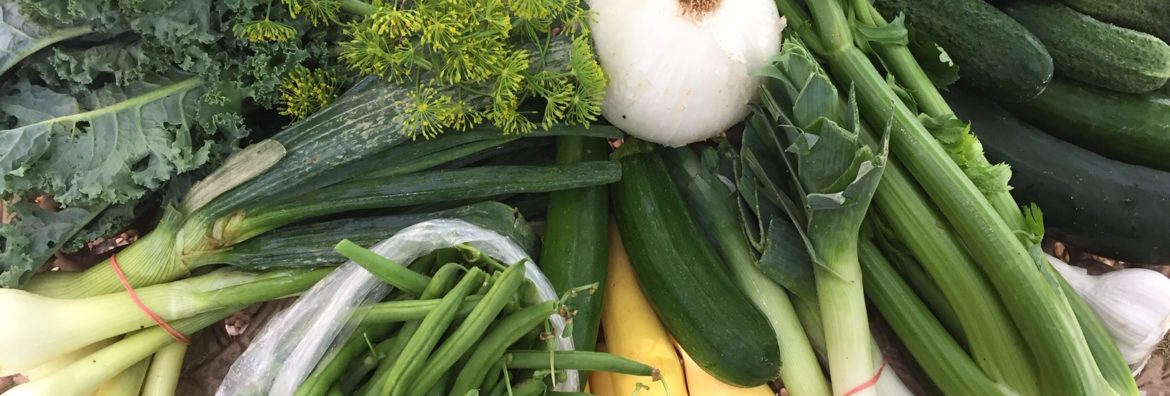In all my years enjoying produce from Riverview, I’m pretty certain I’ve never seen a head of dill in our box. I am so excited! Last week I talked about no-cook refrigerator pickles. Well, now I’ve got to make more. Cucumbers, garlic, that dill seed head, along with some of the zucchini and stems of red bulb scallions are going into quart jars tonight along with the vinegar/sugar solution from last week’s post. I’ll probably throw some jalapeno slices into at least one jar. (Yes, I freeze slices when the jalapenos show up later in the summer and then you’ve got them for use in anything that doesn’t need the crunch of fresh jalapeno, just the heat and flavor.)
Local celery! Local leeks! The box was mostly green this week, but what fun things that we almost never see.
We’ve got a few recipes for celery on the Riverview site. Looking through, I’m reminded about the kale, celery and pineapple power juice recipe there. It came from a subscriber several years ago. I just happen to have a pineapple ripening in the kitchen (the impulse purchase of a husband let loose at the grocery store) and I think I’ll try this recipe this weekend.
If you’re in the mood for soup, there’s a Green Onion-Celery soup from chef Ryan Smith and the beef-celery stir fry that will probably be on our table this week. Both recipes show that celery can be more than just an ingredient in a mirepoix. It’s a great vegetable all on its own.
But leeks? We don’t get those often so there are no leek recipes at grassfedcow.com. The most important tip about working with leeks is how to get rid of the sand/dirt that’s often lurking between those leaves. Ages ago Lynne Sawicki, of the dear departed Sawicki’s in Decatur, did a demo at the Morningside Farmers Market and put her chopped leeks into a big tub of water. She shook them up and then gently lifted out the leeks (which float) while leaving the dirt behind in the bucket. Genius. I’ve been doing it ever since (and then take that tub of water out to the porch to water the houseplants – being that I’m frugal with water even when we are not in a drought).
Anyway, what are you going to do with those clean leeks?
Here’s an idea from Fine Cooking magazine, almost a decade ago. Still good! And you can pick up local shiitakes at most farmers markets these days.
Steamed Salmon with Leeks, Shiitakes and Soy
4 6-ounce boneless, skin-on salmon fillets
1/8 teaspoon crushed red pepper flakes
Kosher salt and freshly ground white or black pepper
1 tablespoon minced garlic
1/2 cup halved and very thinly sliced leeks (white part only), rinsed
1 cup thinly sliced shiitake mushrooms
2 teaspoon toasted sesame oil
1 tablespoon soy sauce
1 tablespoon chopped fresh flat-leaf parsley
Rinse the salmon and pat completely dry. Put the fillets skin side down in a shallow, 9-inch-wide, heatproof bowl or baking dish and let sit at room temperature for about 15 minutes.
Sprinkle the salmon with the red pepper flakes, 1/2 teaspoon salt, and 1/8 teaspoon pepper, and then sprinkle with the garlic, leeks, and mushrooms, in that order.
Add enough water to a 14-inch flat-bottom wok to measure 3/4 inch deep.
Put a 12-inch bamboo steamer in the wok. Cover the steamer and bring the water to a boil over high heat. Uncover, and then carefully set the bowl of salmon in the steamer. Cover the steamer and steam until the fish is just cooked through, 8 to 10 minutes. Check the outer pieces of salmon for doneness first by poking the thickest part with a chopstick or fork to see if it flakes. Using a spatula, transfer the outer pieces to a serving platter and continue to cook the inner two pieces for another 1 to 2 minutes, if necessary. Carefully remove the bowl from the wok and transfer the remaining salmon and any accumulated juice to a platter. Drizzle with sesame oil and soy sauce, and garnish with parsley.

